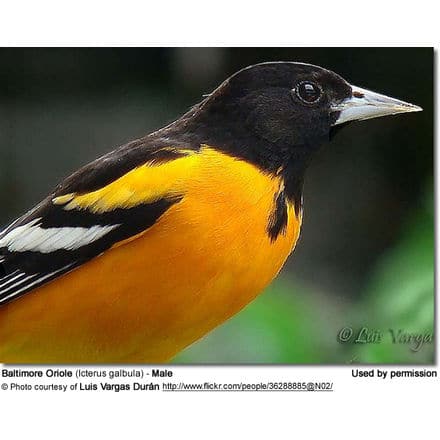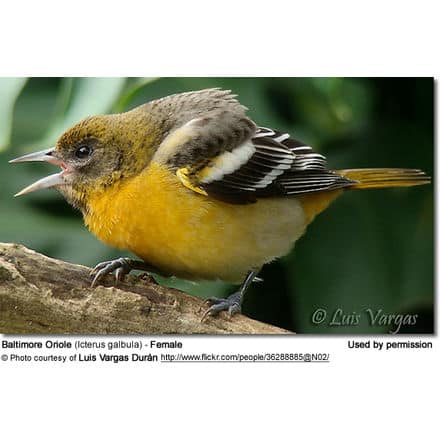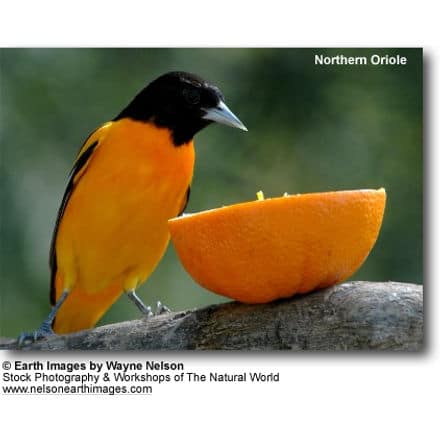Baltimore Orioles aka Northern Oriole or Bullock’s Orioles
The Baltimore Orioles (Icterus galbula) – also known as Abeille’s Oriole – were formerly combined with the Bullock’s Oriole as a single species and both were known as the Northern Oriole.
The Baltimore Oriole is well known in the United States, not only because of the striking orange and black plumage of the male but also because of the name association with the State of Maryland, the City of Baltimore, and the American League baseball club, the Baltimore Orioles, which was named after this bird.
The colors of the male Baltimore Oriole resemble the colors of the coat of arms of Lord Baltimore, the design of which is printed on the Maryland State Flag.
Orange and black – the unofficial “Baltimore colors” or “Maryland colors” – represent a popular and unique symbol of the state of Maryland; and the orange and black plumage of the Baltimore Oriole was the reason why it was named the state bird of Maryland.
Taxonomy:
The Baltimore Oriole or Bullock Oriole Confusion
The Baltimore Oriole’s breeding habitat is the eastern North America (from southern Canada to northern Georgia, northern Louisiana, and southern Texas), while the Bullock Oriole breeds in western North America.
Following tree-planting activities on the Great Plains, both forms extended their ranges and met on the central plains from Saskatchewan to Central Texas.
Even though there are some physical differences, both forms have been found to readily interbreed within their common range and fertile hybrids resulted. In fact, it is estimated that most orioles in the central plains are hybrids.
Therefore, these two forms were combined into a single species.
However, it was observed that in some areas, they are showing a preference for selecting a mate of their own species.
Based on that observation, as well as physical differences (appearance and sounds) and confirmed by DNA studies, they were again considered separate species.


Alternate (Global) Names
Spanish: Bolsero de Baltimore, Bolsero norteño, Chichiltote Norteño, Chorcha norteña, Cigua Canaria Americana, Ictérido anaranjado, Ictérido o Bolsero Norteño, Oriol de Baltimore, Oriol norteño, Turpial … Portuguese: Corrupião-de-baltimore, Corrupião-laranja … Italian: Oriolo di Baltimora … French: Oriole de Baltimore, Oriole du Nord, Oriole orangé … German: Baltimore Trupial, Baltimoretrupial … Russian: ???????????? ??????, ???????????? ??????? ??????? … Japanese: boruchimoamukudorimodoki … Czech: trupiál baltimorský … Danish: Baltimoretrupial … Estonian: jalakaturpial … Finnish: idänlehtoturpiaali … Faroese: Reyðbrystingur … Lithuanian: Baltimorinis trupialas … Dutch: Baltimoretroepiaal, Noordelije troepiaal, Noordelijke troepiaal … Norwegian: Lundtrupial, Nordtrupial … Polish: kacyk pólnocny, kacyk pó?nocny, ?ó?taczek pó?nocny … Slovak: Trupiál vlhovitý … Slovenian: trupial … Swedish: Baltimoretrupial, Nordlig trupial … Turkish: Baltimor Sar?asmas? … Welsh: Euryn Baltimore, Euryn y gogledd

Distribution / Range
Summer (Breeding) Range
The Baltimore Orioles are migratory songbirds that breed in deciduous and mixed woods in Canada (Saskatchewan and Nova Scotia) south to eastern and central portions of the United States.
In the U.S., their breeding range extends from North and South Dakota to Maine; south to Virginia, eastern Texas, central Mississippi, Louisiana, Alabama, northern Georgia, and western South Carolina and North Carolina.
Its range overlaps with the Bullock’s Oriole in the Midwest (Great Plains) of the United States.
Winter (Non-breeding) Range
Most Baltimore Orioles migrate in flocks to winter in southern Mexico, Central America, and northern South America. However, a few stay behind in their breeding range and rely on bird feeders to help them through the winter.
Some will winter in the Southern United States, specifically coastal California, Virginia south to Florida.
In the Caribbean, some winter in the Greater Antilles (Trinidad) east to the Virgin Islands. They are rare winter visitors to the northern Bahamas
In Mexico, they winter from Nayarit (western Mexico) and Veracruz (eastern Mexico) south to the Yucatan Peninsula, where it is a rare visitor.
Their wintering range extends south to northern Colombia and northern Venezuela in South America.
Within their home ranges, non-breeding birds usually occur in small groups of 2 to 5 (rarely 15). However, on occasion, they were observed in large communal roosts (Stiles and Skutch 1989).

Migration
Breeding: Most Baltimore Orioles migrate north in March through April, and arrive in their breeding habitat in the northern U.S. states and Canada in April to May. Males typically arrive a few days before the females.
Wintering: Most Baltimore Orioles migrate south in late July or early August or later to winter in Costa Rica (early September, depart by early May) (Stiles and Skutch 1989); and in South America (mostly October – April (Ridgely and Tudor 1989).
Baltimore Orioles from eastern North America are likely to cross the Gulf of Mexico to reach their winter range (Rohwer and Manning 1990).
This species migrates regularly through the southeastern and south-central United States, as well as coastal California and northeastern Mexico.
Baltimore Orioles are rare vagrants in Western Europe. There are records of them wintering near bird feeders in Oxford (December 2003) and another one in Baltimore, Co. Cork, Ireland (7th – 8th October 2001).
Habitat
Baltimore Orioles inhabit open or partially open woodland with scattered tall trees, riparian woodland (= along river margins and banks), deciduous forest edges, orchards, and groves of shade trees. They are common inhabitants of parks and suburban areas.
During the migration and during the winter season (their southern range), they inhabit humid forest edges, second growth and scrub; coffee and cacao plantations, as well as savanna groves.


Description:
Size
Baltimore Orioles measure between 6.5 – 9 inches (16.5 – 23 cm) in length (from beak to tail), and weigh about 1.2 oz or 34 grams.
Shared Physical Traits / Adults
- sharply-pointed bill
- white bars on the wings (one wing bar in the male, two wing bars in the female)
- similar in plumage throughout the year with no breeding / non-breeding plumage differences
Males
The adult male has a black head, back, wings, and tail – except for orange tips to the outer tail feathers. His underplumage is bright orange. He also has orange-colored shoulders, rump (lower back), and shoulder patches. He has single white wing bars and white wing edges.
Females
Female Baltimore Orioles have mostly olive or yellow-brown upper plumage with darker wings and a dull yellow-orange under plumage. She has two white wing bars and white wing edging.
Immature Birds
Juveniles are similar to females, but are paler overall and lack the black coloration on the head and upper plumage.
Juvenile males have a brighter orange with variable amounts of black on the head. In the second year, the males still have not attained their adult plumage, yet may successfully attract and mate with a female and raise young.
Juvenile males will attain adult plumage in the second fall.

Similar species
Within their range, Baltimore Orioles could be confused with the Hooded Orioles, Orchard Orioles, and Bullock Orioles.
However, the male Baltimore Orioles can easily be differentiated by their entirely black head. Also, the plumage of Orchard Oriole males is a darker, brick-red coloration. The Bullock’s Orioles may be differentiated from Baltimore Orioles by the orange face and black eye lines.
The female can be differentiated from the female Bullock Oriole by her more orange chest and less grey upper plumage.
The Hooded and Orchard Orioles have a more extensive yellow under plumage.
Feeding / Diet
Baltimore Orioles feed on berries, flower nectar, various soft fruits, and insects, including caterpillars.
They typically forage in trees and shrubs but also make short flights to catch insects in midair. In South America, they often feed in flowering trees (Ridgely and Tudor 1989).
They are often seen feeding at hummingbird feeders. Oriole feeders are similar to hummingbird feeders, except they are orange instead of red and have larger perches since orioles perch while feeding, while hummingbirds mostly hover in front of them.
They are also fond of oranges and are sometimes considered a pest of citrus crops.
For those wishing to attract Orioles to their backyard, one easy way to do so is to cut an orange in half and hang those halves up in a tree or offer it on a bird table. Orioles also readily accept offerings of grape jelly.


Breeding / Reproduction
Their breeding season usually commences in late April in its southern range and May in its northern range and lasts until about mid to end of June.
Its deep, tightly woven pouch nest is usually situated in the canopy of hardwood trees, about 25-30 feet (8-9 meters) above the ground. The nest is typically hanging down from the tip of a drooping branch. It is constructed of plant fibers, grasses, tree bark, and string.
The nest is designed to close the opening (entrance) when weighted, as it would be, for example, when there are chicks in the nest. This offers them protection from predators.
The hen lays 3 to 6 greyish-blue eggs with dark brown and black spots. She incubates these eggs for 12 to 14 days. Both parents care for the young, who leave the nest when they are about 12 to 14 days old.
The Brown-headed Cowbird may lay its eggs in the nest of the Baltimore Oriole. This practice is commonly referred to as “brood parasitism.” Many birds will raise those as their own; however, the Baltimore Oriole will eject the eggs of the Brown-headed Cowbird from its nest (Sealy and Neudorf 1995, Condor 97:369-375).
Calls / Vocalizations
The male makes loud clear fluty whistles consisting of single or double notes in short, distinct phrases.



